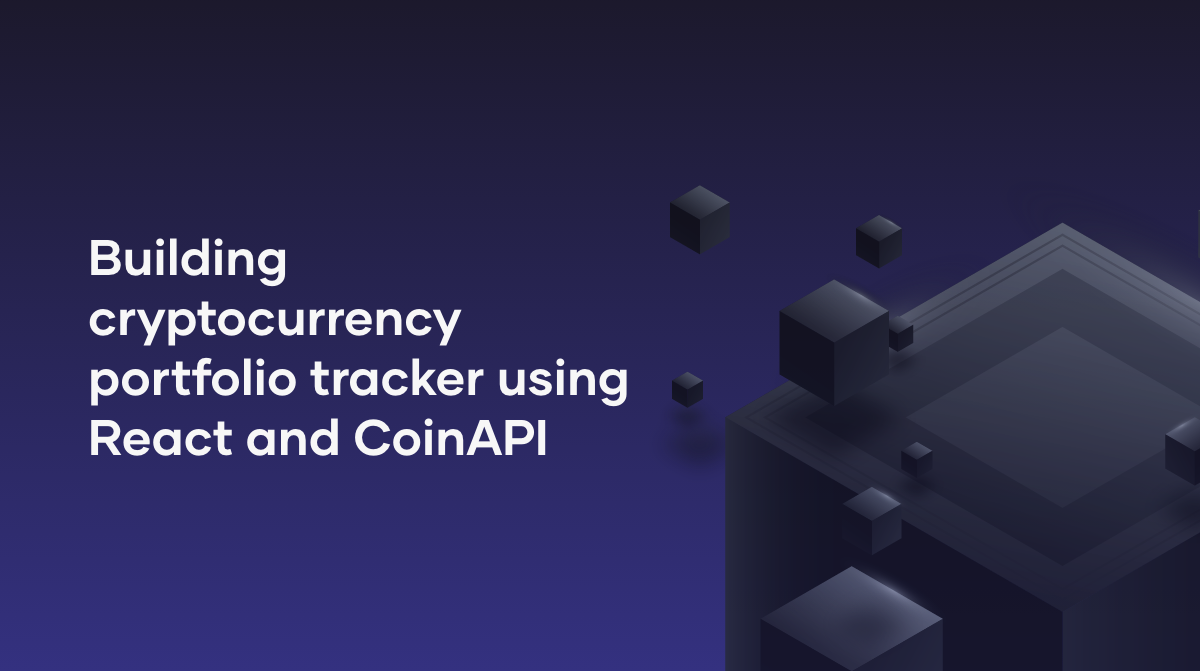Building a Cryptocurrency Portfolio Tracker Using React and CoinAPI
 Ada Szymanska-Krowiak
Ada Szymanska-Krowiak
Getting Started with CoinAPI
Before diving into the tutorial, ensure you have:
Created a CoinAPI account and obtained an API key
Basic familiarity with React and web development
First things first, to make use of CoinAPI, you'll need to create an account and procure an API key. The key is needed to authenticate your application requests. Follow the instructions provided in CoinAPI's Getting Started Guide to set up your account.
Setting Up Your React App
Begin by creating a new React application. You can do this using the create-react-app command or your preferred method.
npx create-react-app coinapi-portfolio-tracker-app
You should have the following project structure:
![]()
Get into the root of the folder in which package.json resides and check whether the project is compiling & starting:
npm start
![]()
Once your app structure is ready and the project successfully compiles, open the App.js file.
Copy and paste the following code into the App.js to see header displaying "CoinAPI Cryptocurrency Portfolio Tracker App".
jsx
import React, { useState } from 'react';
function App() {
return (
<div className="App">
<h1>CoinAPI Cryptocurrency Portfolio Tracker App</h1>
</div>
);
}
export default App;
Start the application again using npm start:
![]()
Retrieving Your Portfolio Data from CoinAPI
CoinAPI provides the v1/exchangerate/asset_id_base endpoint for fetching the latest exchange rates of your assets.
To request BTC/USD, ETH/USD and XRP/USD exchange rates from CoinAPI, we'll use useEffect hook and axios module to retrieve data.
This hook will fetch the exchange rates when the component mounts and then update the portfolio state.
Add the following code as part of the App.js:
import React, { useState } from 'react';
function App() {
const [portfolio, setPortfolio] = useState([]);
useEffect(() => {
async function fetchExchangeRates() {
const assets = ['BTC', 'ETH', 'XRP'];
const promises = assets.map(asset =>
axios.get(`https://rest.coinapi.io/v1/exchangerate/${asset}/USD?apikey=YOUR_API_KEY`)
);
const responses = await Promise.all(promises);
const exchangeRates = responses.reduce((acc, response, index) => {
acc[assets[index]] = response.data.rate;
return acc;
}, {});
setPortfolio(exchangeRates);
}
fetchExchangeRates();
}, []);
return (
<div className="App">
<h1>CoinAPI Cryptocurrency Portfolio Tracker App</h1>
</div>
);
}
export default App;
Note: Make sure to replace YOUR_API_KEY it with the API key you have obtained via the CoinAPI website.
To make exchange rates appear in your web app, update the return part with the following code:
return (
<div className="App">
<h1>CoinAPI Cryptocurrency Portfolio Tracker App</h1>
<ul>
{Object.entries(portfolio).map(([asset, exchangeRate]) => (
<li key={asset}>{asset}: {exchangeRate}</li>
))}
</ul>
</div>
);
Here's the complete App.js code:
import React, { useState, useEffect } from 'react';
import axios from 'axios';
function App() {
const [portfolio, setPortfolio] = useState([]);
useEffect(() => {
async function fetchExchangeRates() {
const assets = ['BTC', 'ETH', 'XRP'];
const promises = assets.map(asset =>
axios.get(`https://rest.coinapi.io/v1/exchangerate/${asset}/USD?apikey=YOUR_API_KEY`
);
const responses = await Promise.all(promises);
const exchangeRates = responses.reduce((acc, response, index) => {
acc[assets[index]] = response.data.rate;
return acc;
}, {});
setPortfolio(exchangeRates);
}
fetchExchangeRates();
}, []);
return (
<div className="App">
<h1>CoinAPI Cryptocurrency Portfolio Tracker App</h1>
<ul>
{Object.entries(portfolio).map(([asset, exchangeRate]) => (
<li key={asset}>{asset}: {exchangeRate}</li>
))}
</ul>
</div>
);
}
export default App;
Before starting the application, make sure to install axios module via npm install axios command.
Then start the application with npm start and check out the result:
![]()
Styling Your Portfolio Tracker
Having fetched your portfolio data, you can now proceed to style your tracker.
You can use raw CSS or opt for a UI library like Bootstrap or Material UI to enhance the look of your portfolio tracker.
Here we'll use a CSS styling approach and the following classes: portfolio, portfolio-item, asset-name and asset-rate.
Extend the GUI part with className attributes values as follows:
return (
<div className="App">
<h1>CoinAPI Cryptocurrency Portfolio Tracker App</h1>
<div className="portfolio">
{Object.entries(portfolio).map(([asset, exchangeRate]) => (
<li key={asset} className="portfolio-item">
<span className="asset-name">{asset}/USD:</span>
<span className="asset-rate">{exchangeRate}</span>
</li>
))}
</div>
</div>
);
then update index.css with CSS class implementation:
.portfolio {
padding: 1em;
}
.portfolio-item {
display: flex;
align-items: center;
font-size: 18px;
margin-bottom: 10px;
}
.asset-name {
font-weight: bold;
margin-right: 10px;
color: #007bff;
}
.asset-rate {
color: #28a745;
}
.portfolio-item:hover {
transform: scale(0.95);
transition: transform 0.2s ease-in-out;
}
Retrieve data at regular intervals
Rather than repeatedly refreshing the application to obtain the most recent exchange rates, we can enhance it to fetch this data at specified intervals and automatically update the view. To update the exchange rates every 5 seconds, you can use the setInterval function in React.
import React, { useState, useEffect } from 'react';
import axios from 'axios';
function App() {
const [portfolio, setPortfolio] = useState([]);
useEffect(() => {
async function fetchExchangeRates() {
const assets = ['BTC', 'ETH', 'XRP'];
const promises = assets.map(asset =>
axios.get(`https://rest.coinapi.io/v1/exchangerate/${asset}/USD?apikey=YOUR_API_KEY`)
);
const responses = await Promise.all(promises);
const exchangeRates = responses.reduce((acc, response, index) => {
acc[assets[index]] = response.data.rate;
return acc;
}, {});
setPortfolio(exchangeRates);
}
fetchExchangeRates();
// Fetch exchange rates every 5 seconds
const intervalId = setInterval(fetchExchangeRates, 5000);
// Clean up the interval when the component unmounts to avoid memory leaks
return () => clearInterval(intervalId);
}, []);
return (
<div className="App">
<h1>CoinAPI Cryptocurrency Portfolio Tracker App</h1>
<div className="portfolio">
{Object.entries(portfolio).map(([asset, exchangeRate]) => (
<li key={asset} className="portfolio-item">
<span className="asset-name">{asset}/USD:</span>
<span className="asset-rate">{exchangeRate}</span>
</li>
))}
</div>
</div>
);
}
export default App;
By following these steps, you'll create a basic cryptocurrency portfolio tracker using React and CoinAPI.
![]()
For more information, you can check REST API Exchange Rates docs
If you would like the data to be sent to you in real-time, check our Real-time data visualization with javascript or real-time trades stream using WebSocket with different languages and how-to articles.
Happy coding!
Subscribe to my newsletter
Read articles from Ada Szymanska-Krowiak directly inside your inbox. Subscribe to the newsletter, and don't miss out.
Written by

Ada Szymanska-Krowiak
Ada Szymanska-Krowiak
I'm Adrianna Szymanska-Krowiak, a dedicated Business-to-Developer (B2D) specialist with a passion for technology and innovation. Before diving into the world of APIs at CoinAPI, I cut my teeth in the tech industry at Dronehub, a leading drone company. There, I gained invaluable experience and insights into tech-driven solutions. Now, at CoinAPI, I focus on API products, using my expertise to bridge the gap between developers and business needs. My journey has been an exciting blend of technology and business, and I'm thrilled to contribute to the ever-evolving landscape of API solutions.